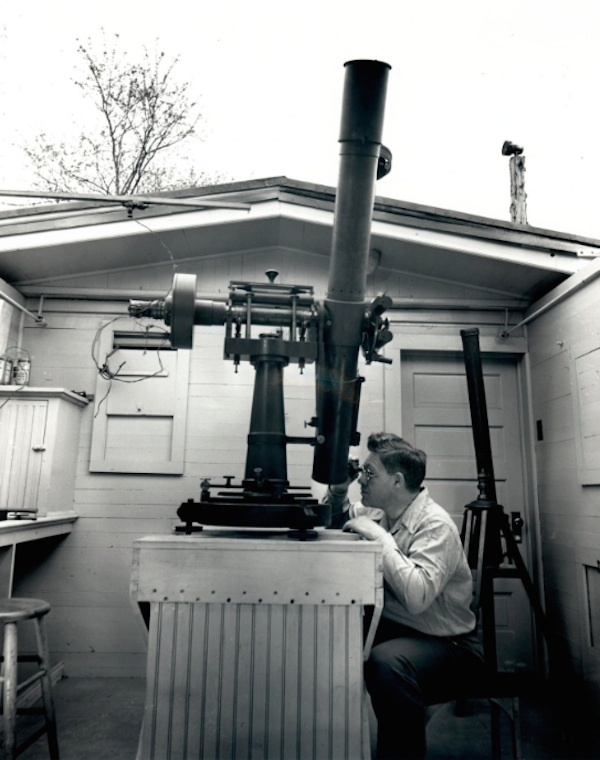.
A workhorse telescope is back in Gaithersburg, Md., not far from its old home

Earl Williams, an observer in the 1940s with the what was then called the U.S. Coast and Geodetic Survey — today's National Geodetic Survey — looks through the telescope in Gaithersburg, Md., that helped scientists study the Chandler wobble. Until it was shuttered in 1982, the observatory was one of five around the world that studied a wobble in the Earth’s axis. (U.S. Coast and Geodetic Archives)
-
It was a homecoming of sorts when the telescope arrived at the Gaithersburg Community Museum last week. The telescope — a brass cylinder about five feet tall and painted black — had spent its entire working life a half-mile away, pointed at the heavens. Its ultimate mission wasn’t to glean information from the stars, but to discover something about the Earth.
And also about Earthlings. Such as: There are humans for whom the perfect job is sitting up all night, every night, looking at the stars. For nearly 100 years, a succession of men did that in a little wooden shed in Montgomery County, Md., at a place called the Gaithersburg Latitude Observatory.
“I very much had wanted that job,” Dave Doyle told me when I rang him up recently at his house in Silver Spring, Md.
Dave retired in 2013 from the National Geodetic Survey, the part of the National Oceanic and Atmospheric Administration charged with figuring out exactly where everything is in this great land of ours, from mountains to coastlines. He started there in 1972, fresh out of the Army. One day, Dave was dispatched to run some material from the office in Rockville, Md., to a place he hadn’t known existed: an observatory.
“I drive up to Gaithersburg, I pull in and I’m in love,” he said.
There, Dave found a squat, flat-topped, white wooden building, with louvered outer walls and a nifty roof that could be slid open by pulling on a rope on a pulley. Inside — set onto a concrete pier — was the telescope. Next door was the house where the observer lived with his family, a lighthouse-keeper far from the sea.
“The guy lives right there,” Dave said. “There’s nobody to bother him. He gets to do his thing.”
The observer’s thing was to note the exact positions of 12 to 18 pairs of stars as they passed overhead. The same thing happened every cloudless night at four other observatories arranged along the 39th parallel: in Ukiah, Calif.; Mizusawa, Japan; Kitab in Uzbekistan; and Carloforte, Italy.
Why? Because of something called the Chandler wobble, which sounds like a jazz-era dance craze but is actually a variation in the Earth’s latitude discovered in 1891 by U.S. astronomer Seth Carlo Chandler. Our planet does not spin perfectly on its axis. It wobbles, like a top spinning down.
The Gaithersburg observatory was built in 1899 to track that wobble. Funding issues left it inactive between 1915 and 1932, when it was started up again. Throughout World War II, all five stations — three in Allied nations, two in Axis countries — sent their readings in.
By 1982, more sophisticated wobble-measuring methods had arisen and the very last observer — Mac Curran — made his very last observation.
“Real nice guy,” Dave said. “He taught me the ins and outs, as much as I could absorb. But once GPS came along, I knew we were not going to do this optically anymore.”
In 1989, the observatory became a National Historic Landmark. It’s owned now by the city of Gaithersburg, and the park it sits in — right next to Gaithersburg High School — is the setting for regular skywatching programs, including an eclipse-viewing party last month that drew 3,500 people.
Last week, Dave went out to Corbin, Va., to help haul the heavy telescope back from a National Geodetic Survey storage facility. It wouldn’t be prudent to put the precision instrument back in the observatory now that it’s not staffed, so it’s the newest exhibit in the Gaithersburg Community Museum, which is open 10 a.m. to 3 p.m., Tuesday through Saturday.
Even without its telescope, the observatory kept making history. The grounds are studded with survey markers, including one called “Observatory Reference Marker 1,” or RM-1. When GPS was being developed, companies would head to Gaithersburg with representatives of the Geodetic Survey and the National Institute of Standards and Technology to test their latest receivers. Standing on RM-1, how accurate would their equipment be?
You can test your GPS, too. Enter “100 Desellum Ave., Gaithersburg, MD 20877” if you want to see Observatory Park and “9 S. Summit Ave., Gaithersburg, MD 20877” if you want to see the telescope that once resided there.
Quelle: The Washington Post
